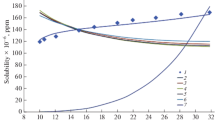Abstract
In this work, regular solution theory was applied to study the solubility of solids in a supercritical fluid (SCF) with and without cosolvent, and a new model for binary and ternary systems was proposed. The activity coefficient can be obtained from the model and the solubility can then be calculated easily. For a binary system there are two adjustable parameters and for a ternary system, four adjustable parameters; the parameters are related to the interactions between molecules in solution. The proposed model was compared with the HSVDW1 and HSVDW2 models. The calculated results show that the proposed model is more accurate, and the AAD for the three models is 4.5%, 7.9% and 18.5%, respectively. The model was further used to correlate the solubility data of 2-naphthol in SC CO2 with and without cosolvent measured by us before, and the overall AAD is 3.23%.
Similar content being viewed by others
References
Ashour, I., Almehaideb, R., Fateen, S. E. and Aly, G., “Representation of Solid-Supercritical Fluid Phase Equilibria using Cubic Equation of State,”Fluid Phase Equilibrium,167, 41 (2000).
Baek, J. K., Kim, S., Lee, G. S. and Shim, J. J., “Density Correlation of Solubility of C.I. Disperse Orange 30 Dye in Supercritical Carbon Dioxide,”Korean J. Chem. Eng.,21, 230 (2004).
Bamberger, T., Erickson, J. C. and Cooney, C. L., “Measurement and Model Prediction of Solubilities of Pure Fatting Acids, Pure Triglycerides, and Mixtures of Triglycerides in Supercritical Carbon Dioxide,”J. Chem. Eng. Data,33, 327 (1988).
Barton, A., “Handbook of Solubility Parameters and Other Cohesive Parameters,” CRC, Boca Raton, FL, 1 (1983).
Bush, D. and Eckert, C. A., “Prediction of Solid-Fluid Equilibria in Supercritical Carbon Dioxide using Linear Solvation Energy Relationships,”Fluid Phase Equilibrium,150, 479 (1998).
Chen, P., Tang, M. and Chen, Y., “Calculations of the Solubility of Solids in Supercritical Fluids using the Peng-Robinson Equation of State and aModified Mixing Model”,Ind. Eng. Chem. Res.,34, 332 (1995).
Chrastil, J., “Solubility of Solids and Liquids in Supercritical Gases,”J. Phys. Chem.,86, 3016 (1982).
Dobbs, J. M., Wong, J. M. and Lahiere, R. J., “Modification of Supercritical Fluid Phase Behavior using Polar Cosolvents,”Ind. Eng. Chem. Res.,26 (1), 56 (1987).
Dobbs, J. M., Wong, J. M. and Johnston, K. P. J., “Nonpolar Co-solvent for Solubility Enhancement in Supercritical Carbon Dioxide”,Chem. Eng. Data,31(3), 303 (1986).
Gurdial, G. S. and Foster, N. R., “Solubility of O-Hydroxybenzoic Acid in Supercritical Carbon Dioxide”,Ind. Eng. Chem. Res.,30, 575 (1991).
Hwang, J., Kim, C. H. and Lim, G. B., “Experimental Studies and Discrete Thermodynamic Modeling on Supercritical CO2 Extractions of a Hexadecane and Crude Oil,”Korean J. Chem. Eng.,12, 244 (1995).
Hu, Y., “Molecule Thermodynamics of Fluid,” High Education Press, Beijing, 310 (1982).
Johnston, K. P. and Eckert, C. A., “Modeling Supercritical Mixtures: How Predictive Is It?”Ind. Eng. Chem. Res.,28, 1115 (1989).
Valderrama, J. O. and Silva, A., “Modified Soave-Redlich-Kwong Equations of State Applied to Mixtures Containing Supercritical Carbon Dioxide”,Korean J. Chem. Eng.,20, 709 (2003).
Li, Q., Zhang, Z., Zhong, C., Liu, Y. and Zhou, Q., “Solubility of Solid Solutes in Supercritical Carbon Dioxide with and without Cosolvents”,Fluid Phase Equilibrium,207, 183 (2003a).
Li, Q., Zhong, C., Zhang, Z., Liu, Y. and Zhou, Q., “An Equilibrium Model for the Correlation of the Solubility of Solids in Supercritical Fluids with Cosolvent,”Sep. Sci. & Tech.,38, 1705 (2003b).
Mendez-Santiago, J. and Teja, A. S., “The Solubility of Solids in Supercritical Fluids,”Fluid Phase Equilibrium,158, 501 (1999).
Noh, M. J., Kim, T. G., Hong, I. K. and Yoo, K. P., “Measurements and Correlation of Effect of Cosolvents on the Solubilities of Complex Molecules in Supercritical Carbon Dioxide,”Korean J. Chem. Eng.,12, 48 (1995).
Patal, N. C. and Teja, A. S., “A New Cubic Equation of State for Fluids and Fluid Mixtures,”Chem. Eng. Sci.,37, 463 (1982).
Reid, R.C., Prausnitz, J. M. and Poling, B. E., “The Properties of Gases and Liquid,” 4th Edition, McGraw-Hill, New York, 102 (1987).
Soave, G., “A Simple Model for the Supercritical Extraction of Solids,”Journal of Supercritical Fluids,19, 19 (2000).
Zhu, Z., “Supercritical Fluid Technology Principles and Applications,” Chemical Engineering Press, Beijing, 61 (2000).
Zigger, D. H. and Eckert, C. A., “Correlation and Prediction of SolidSupercritical Fluid Phase Equilibria,”Ind. Eng. Chem. Process Des. Dev.,22, 582 (1983).
Author information
Authors and Affiliations
Corresponding author
Rights and permissions
About this article
Cite this article
Li, Q., Zhong, C., Zhang, Z. et al. Modeling of the solubility of solid solutes in supercritical CO2 with and without cosolvent using solution theory. Korean J. Chem. Eng. 21, 1173–1177 (2004). https://doi.org/10.1007/BF02719490
Received:
Accepted:
Issue Date:
DOI: https://doi.org/10.1007/BF02719490




